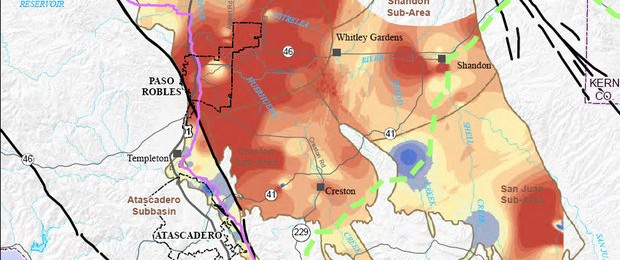Paso Robles Groundwater Levels
Paso Robles groundwater levels could drop 70 feet more by 2040, report says
BY DAVID SNEED
dsneed@thetribunenews.com
A new analysis of the Paso Robles groundwater basin shows that aquifer levels near Paso Robles will drop an additional 70 feet if pumping continues unabated over the next 30 years.
The new hydrological analysis commissioned by the San Luis Obispo County Department of Public Works updates the calculations of how much water was pumped from the basin from 1981 to 2011 and estimates how much will be pumped from 2012 to 2040 under growth and no-growth scenarios. (Click here to read the executive summary of the report »)
The no-growth scenario assumes no new pumping from the basin. The growth scenario assumes a 1 percent increase in vineyard, municipal, rural domestic and small commercial pumping.
County supervisors disagree on the severity of the problem but said this week that management of the basin to prevent over-pumping is needed.
“It suggests that if we don’t do something significantly different, there will be very serious problems going forward,” said Supervisor Bruce Gibson, chairman of the board. “Right now we have to deal with the stark reality that we have a basin that is in serious decline.”
An old analysis examined water use in the basin from 1981 through 1997. That analysis showed that water levels throughout much of the basin had dropped by 70 feet or more during that period.
The new analysis, called the Paso Robles Groundwater Basin Model Update, is intended to give the latest information to the Board of Supervisors and others to use to make decisions about how to manage the basin, said Courtney Howard, county water resources engineer. Supervisors are scheduled to have a presentation and discussion of the update Jan. 13.
“Our focus on this was to get a tool we can use to get an idea of the status of the basin,” she said.
Highlights of the report include the following:
Water storage in the basin declined an average of 2,473 acre-feet per year from 1981 through 2011. The previous study had put the deficit at 3,300 acre-feet per year.
The perennial yield of the basin is 89,700 acre-feet per year, which is how much water can be pumped from the basin without causing further declines. Previous analysis had put the yield at 97,700 acre-feet a year.
The Estrella sub-area of the basin is projected to be hardest hit. This is an area stretching north and east from Paso Robles past San Miguel that contains many vineyards. A section of the Creston sub-area southeast of Paso Robles is also hard hit.
Under a scenario of no growth, pumping would exceed inflows by 5,592 acre-feet a year, and pockets in the Estrella sub-area would see aquifer declines of as much as 60 feet over the next 30 years.
Under a scenario of an annual 1 percent growth in water usage, outflows would exceed inflows by 20,900 acre-feet a year, and aquifer levels would drop by more than 70 feet over much of the Estrella sub-area over the next 30 years.
Crop irrigation accounts for 68 percent of the water pumped from the basin. Of that, more than 80 percent is used to irrigate vineyards.
Those familiar with the Paso Robles groundwater basin said the update reaffirms what they already knew — that the basin is being over-pumped and steps must be taken to bring it into balance.
The county is already taking steps to manage the basin. In August 2013, supervisors passed an emergency ordinance that prohibits any new pumping from the basin unless it is offset by an equal amount of conservation.
Supervisors have also directed staff to begin the process of petitioning the county Local Agency Formation Commission to form a water-management district for the basin. Sue Luft, a North County resident who advocated for a water district, said the new analysis shows the basin needs some sort of management structure to bring it back into balance.
“Hopefully, the public can see that we are in overdraft; it is only going to get worse so we have to do something,” she said. “Hard decision will be necessary and business as usual is not working.”
Supervisor Debbie Arnold, whose district includes part of the Paso basin, said the new analysis reaffirms her long-held stance that the basin has some areas that are in decline but many others that are not.
Gibson disagreed, saying the basin needs to be managed as a whole.
“I don’t think that there is evidence to manage one part of the basin differently than another,” he said. “This is just at the start of a huge work effort that we need to take head on.”
Arnold has resisted a one-size-fits-all solution and has not supported the formation of a water-management district. Instead, she has supported the Board of Supervisors’ efforts to manage the district using its Flood Control and Water Conservation District.
Supervisor Frank Mecham, whose district includes most of the Paso basin, said the update shows the basin is out of balance but it is not as severe a crisis as he had feared. It shows that something needs to be done now to start bringing the basin into balance.
“I don’t want to go through another drought cycle with nothing in place to manage the basin,” he said.
Read more here: Groundwater Draft Executive Summary

